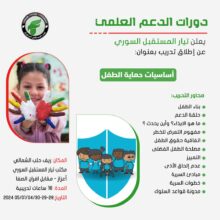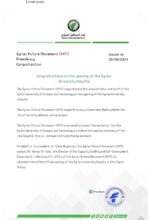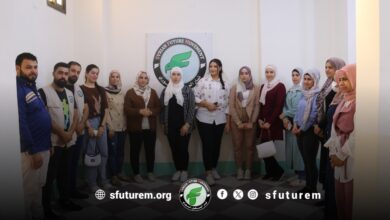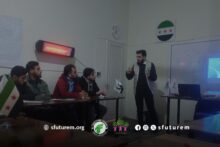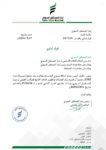The Reality of the Agricultural Sector in Syria, A Model from Northern Syria.

Introduction:
Agriculture is a key sector in northern Syria, providing more than 20% of job opportunities and 30% of the gross domestic product (GDP). It significantly contributes to food security, producing enough agricultural resources to meet the basic needs of the local population. The importance of the agricultural sector becomes clear through the analysis of agricultural productivity, the value of agricultural exports, and the employment opportunities that agriculture offers.
Additionally, the agricultural sector has been a primary source of income for more than 70% of the population in these areas, whether through farming, marketing, transportation, or trade.
Northwest Syria is known for its diverse agricultural crops, including grains (wheat and barley), seasonal vegetables, and legumes, as well as fruit trees such as olive and pistachio trees. This area’s richness in agricultural products is due to several factors, the most important being the availability of agricultural labor, the suitable climate, soil fertility, and access to groundwater. For example, the cultivated area in the Euphrates Shield region (northern and northeastern rural Aleppo) is estimated to be around 222,030 hectares, with 70% planted with wheat and barley, and approximately 9% with olive trees, while the remaining land is used for growing vegetables, potatoes, fava beans, chickpeas, and lentils. In Afrin, the cultivated area is estimated at 92,981 hectares, with olive trees representing 90% of the crops, totaling around 14 million trees, while the remaining 10% of the land is planted with other crops.
Excluding exports,
the agricultural sector in northern Syria faces major challenges due to the ongoing conflict, which has led to the destruction of agricultural infrastructure, including damage to irrigation systems, the destruction of farming machinery, and land contamination with explosives. Furthermore, drought and the destruction of dams and canals have caused an increase in the prices of agricultural inputs such as fertilizers and seeds, leading to higher production costs. As a result of the conflict and difficult living conditions, many farmers have migrated, in addition to the degradation of soil due to the intensive use of pesticides and fertilizers.
The negative impacts on the economy have been numerous, including:
- Decline in agricultural production: leading to food shortages and rising prices.
- Increase in poverty and unemployment: especially in rural areas.
- Deterioration of food security: threatening the health and safety of the population.
Challenges and their impact on the agricultural reality in northern Syria:
Northern Syria serves as a stark example of the complex overlap between politics, security, and the economy, where multiple factors combine to create significant challenges for the agricultural sector, one of the main pillars of the local economy.
When discussing the political and military challenges, lack of security stability stands out as one of the most significant issues. The ongoing conflict for years presents the greatest obstacle to any form of sustainable development, including agriculture. The repeated escalations, military operations, and shifting frontlines negatively affect farmers, preventing them from accessing their lands and farms.
In addition, the multiplicity of active actors complicates the situation. The presence of various armed and political entities on the ground disperses efforts and leads to conflicting interests, complicating decision-making processes related to the agricultural sector.
Moreover, corruption and favoritism in the distribution of agricultural aid and projects reduce the effectiveness of these efforts, depriving many farmers of their rights.
Perhaps the greatest threat and challenge is the absence of a clear agricultural policy. The lack of a clear vision and comprehensive strategy for the development of the agricultural sector leads to random and unplanned decisions.
On the geopolitical front, external interventions pose another challenge. Multiple foreign interventions in northern Syria affect policy decisions related to agriculture, making it difficult to achieve long-term stability. In addition, northern Syria is subjected to a severe economic blockade, coupled with the impact of sanctions on the Syrian regime, which limits the ability of farmers to access agricultural inputs and markets for their products.
As for the influence of various controlling forces on the agricultural reality, there is competition over resources by these forces controlling water resources and agricultural lands, leading to poor distribution and suboptimal utilization of these resources.
In addition to the presence of multiple and competing agricultural systems in different areas, it becomes difficult to implement unified agricultural policies.
There is also the difficulty in coordinating between the various active entities, which hinders the execution of large-scale agricultural projects.
Thus, the resulting impacts on the agricultural sector will be as follows:
- Decrease in agricultural production: due to the destruction of agricultural infrastructure, water shortages, and the migration of farmers.
- Increase in food prices: due to reduced production and higher production costs.
- Deterioration of food security: threatening the health and safety of the population.
- Increase in poverty and unemployment: particularly in rural areas.
The challenges facing the agricultural sector in northern Syria are complex and intertwined, requiring comprehensive and long-term solutions. This necessitates working towards achieving security stability, building strong institutions capable of managing agricultural resources, providing financial and technical support to farmers, and developing agricultural policies that take into account the geopolitical challenges.
Opportunities to Address Agricultural Sector Challenges in Northern Syria:
Despite the immense challenges facing the agricultural sector in northern Syria, there are real opportunities for its revival and development. These opportunities require concerted efforts and international and regional cooperation, and include the following:
- Utilizing local expertise and traditional knowledge through:
- A. Local farmers who possess deep knowledge of the local environment and suitable crop types. This expertise can be used to develop sustainable farming methods.
- B. Agricultural cooperatives, which can play an important role in providing services to farmers and marketing their products.
- Adopting sustainable agriculture through organic farming:
- This can help improve soil quality and agricultural products, and reduce reliance on harmful chemicals.
- In addition, modern irrigation can help optimize water use and reduce costs.
- Diversifying crops can also reduce risks associated with climate fluctuations and pest infestations.
- Supporting research and development through:
- A. Developing new crop varieties suited to the region’s climate and soil conditions.
- B. Studying pests and diseases and developing biological control methods.
- C. Developing new techniques to improve productivity and reduce costs.
- Building agricultural infrastructure by:
- A. Repairing irrigation systems and developing dams and water reservoirs.
- B. Constructing agricultural roads to facilitate the transport of agricultural products.
- C. Establishing agricultural markets to provide a place to sell agricultural products at fair prices.
- Supporting agricultural value chains through three components:
- A. Marketing and developing effective methods for agricultural products, both locally and regionally.
- B. Establishing factories to process agricultural products and increase their added value.
- C. Packaging and storing agricultural products to preserve them and facilitate their transportation and storage.
- Regional and international cooperation:
- by benefiting from the exchange of expertise with other countries in the field of agriculture, attracting investments to develop the agricultural sector, and obtaining food, humanitarian, and technical aid.
- Strengthening the role of the private sector
- by encouraging investment in the agricultural sector through providing necessary incentives, in addition to simplifying procedures related to registering agricultural lands and establishing agricultural companies.
- Raising awareness about the importance of agriculture:
- by educating farmers on the importance of implementing sustainable agricultural practices and raising consumer awareness about the importance of supporting local agricultural products.
Conclusion:
Syria’s total area is 18.5 million hectares, with approximately 6.5 million hectares being arable land and forest areas, accounting for 32.8 percent of Syria’s total area. The remaining portion consists of arid regions in the Syrian desert. Over 20 percent of Syrians work in agriculture, where crops such as grains, vegetables, fruits, olives, and cotton are cultivated.
The estimated losses resulting from the damage to the agricultural sector due to the war amount to around 16 billion US dollars. The damage to agricultural assets and production resources, including equipment, farms, veterinary clinics, animal shelters, greenhouses, and irrigation systems, is estimated at over 3 billion US dollars. Crop production losses are valued at approximately 6.3 billion US dollars, while livestock sector losses are estimated at around 5.5 billion US dollars, with about 80 million US dollars lost in the fish farming sector.
Reviving the agricultural sector is a strategic goal, starting with the revival of each region currently under the control of local authorities. Therefore, our strategic vision for the revival of the agricultural sector in Syria stems from the region of northern Syria as a model that can be built upon for the future. The agricultural sector in Syria, in general, and northern Syria, in particular, requires concerted efforts from all parties. This was highlighted in a previous article from the Economic Office of the Syrian Future Movement (SFM) titled “Agriculture in Northern Syria, a Lever for Development.” Reviving it in an optimal way will take significant time and effort, given the current complex military and political situation. Nevertheless, the opportunities to achieve this goal are substantial, and they can contribute to achieving food security and improving the living standards of the population.
Economic Office
Research Team
Research and Studies Section
Studies
Syrian Future Movement (SFM)
The References:
- The State of Major Agricultural Crops in Syria After 2010
- Agriculture in Northern Syria: A Catalyst for Development
- Including Damask Roses and Saffron… Cultivations Making a Comeback
- Agricultural Support for Farmers in Northern Aleppo Governorate
- Agriculture in Northern Syria
- Northern Syria Faces Desertification
- Organic Farming in Syria
- Syria’s Agricultural Crisis
- How Has the War Affected Agriculture in Northern Syria?
